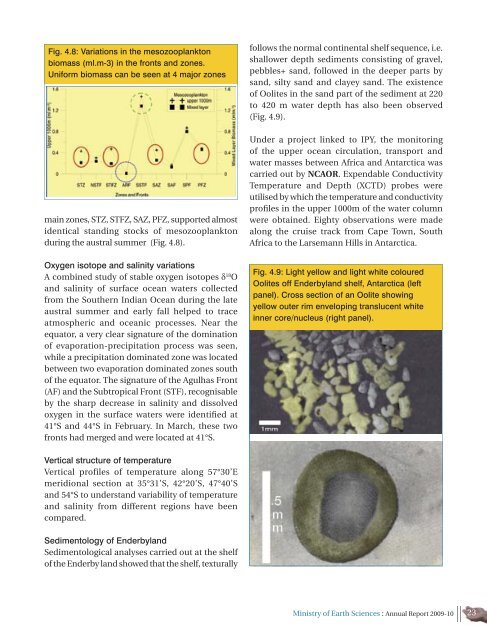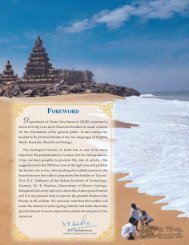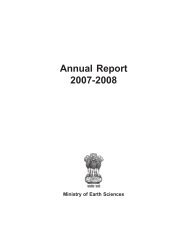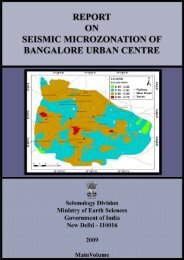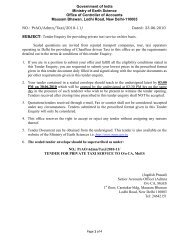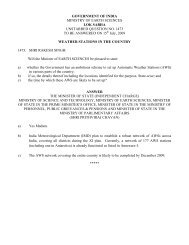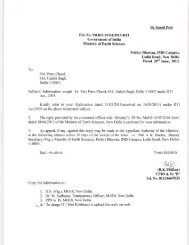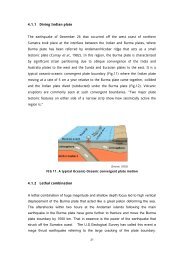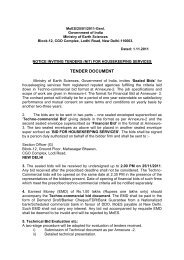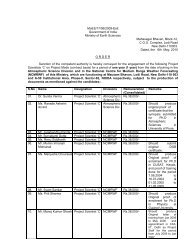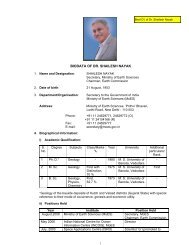Annual Report 2009-2010 - Ministry Of Earth Sciences
Annual Report 2009-2010 - Ministry Of Earth Sciences
Annual Report 2009-2010 - Ministry Of Earth Sciences
Create successful ePaper yourself
Turn your PDF publications into a flip-book with our unique Google optimized e-Paper software.
Fig. 4.8: Variations in the mesozooplankton<br />
biomass (ml.m-3) in the fronts and zones.<br />
Uniform biomass can be seen at 4 major zones<br />
main zones, STZ, STFZ, SAZ, PFZ, supported almost<br />
identical standing stocks of mesozooplankton<br />
during the austral summer (Fig. 4.8).<br />
Oxygen isotope and salinity variations<br />
A combined study of stable oxygen isotopes δ 18 O<br />
and salinity of surface ocean waters collected<br />
from the Southern Indian Ocean during the late<br />
austral summer and early fall helped to trace<br />
atmospheric and oceanic processes. Near the<br />
equator, a very clear signature of the domination<br />
of evaporation-precipitation process was seen,<br />
while a precipitation dominated zone was located<br />
between two evaporation dominated zones south<br />
of the equator. The signature of the Agulhas Front<br />
(AF) and the Subtropical Front (STF), recognisable<br />
by the sharp decrease in salinity and dissolved<br />
oxygen in the surface waters were identified at<br />
41°S and 44°S in February. In March, these two<br />
fronts had merged and were located at 41°S.<br />
follows the normal continental shelf sequence, i.e.<br />
shallower depth sediments consisting of gravel,<br />
pebbles+ sand, followed in the deeper parts by<br />
sand, silty sand and clayey sand. The existence<br />
of Oolites in the sand part of the sediment at 220<br />
to 420 m water depth has also been observed<br />
(Fig. 4.9).<br />
Under a project linked to IPY, the monitoring<br />
of the upper ocean circulation, transport and<br />
water masses between Africa and Antarctica was<br />
carried out by NCAOR. Expendable Conductivity<br />
Temperature and Depth (XCTD) probes were<br />
utilised by which the temperature and conductivity<br />
profiles in the upper 1000m of the water column<br />
were obtained. Eighty observations were made<br />
along the cruise track from Cape Town, South<br />
Africa to the Larsemann Hills in Antarctica.<br />
Fig. 4.9: Light yellow and light white coloured<br />
Oolites off Enderbyland shelf, Antarctica (left<br />
panel). Cross section of an Oolite showing<br />
yellow outer rim enveloping translucent white<br />
inner core/nucleus (right panel).<br />
Vertical structure of temperature<br />
Vertical profiles of temperature along 57°30’E<br />
meridional section at 35°31’S, 42°20’S, 47°40’S<br />
and 54°S to understand variability of temperature<br />
and salinity from different regions have been<br />
compared.<br />
Sedimentology of Enderbyland<br />
Sedimentological analyses carried out at the shelf<br />
of the Enderby land showed that the shelf, texturally<br />
<strong>Ministry</strong> of <strong>Earth</strong> <strong>Sciences</strong> : <strong>Annual</strong> <strong>Report</strong> <strong>2009</strong>-10 23


